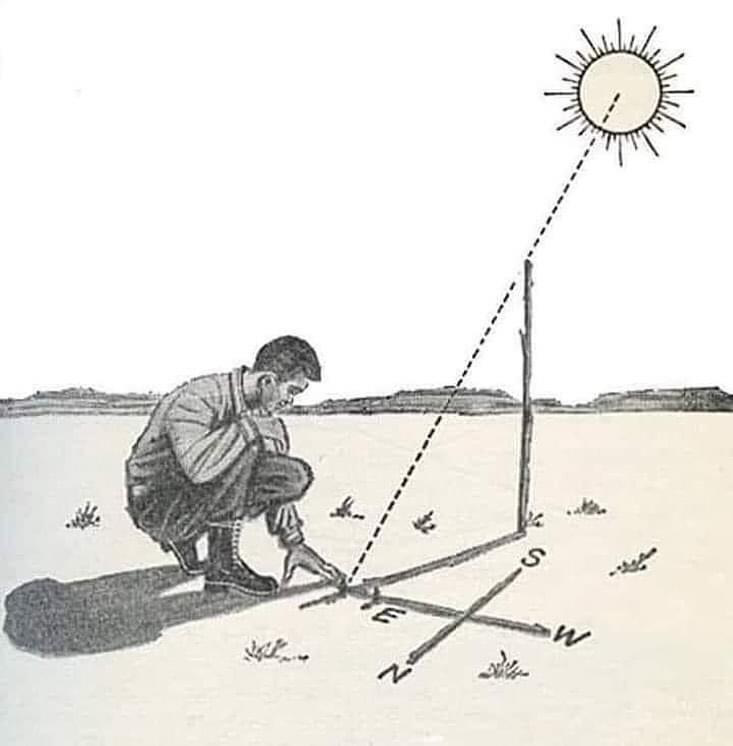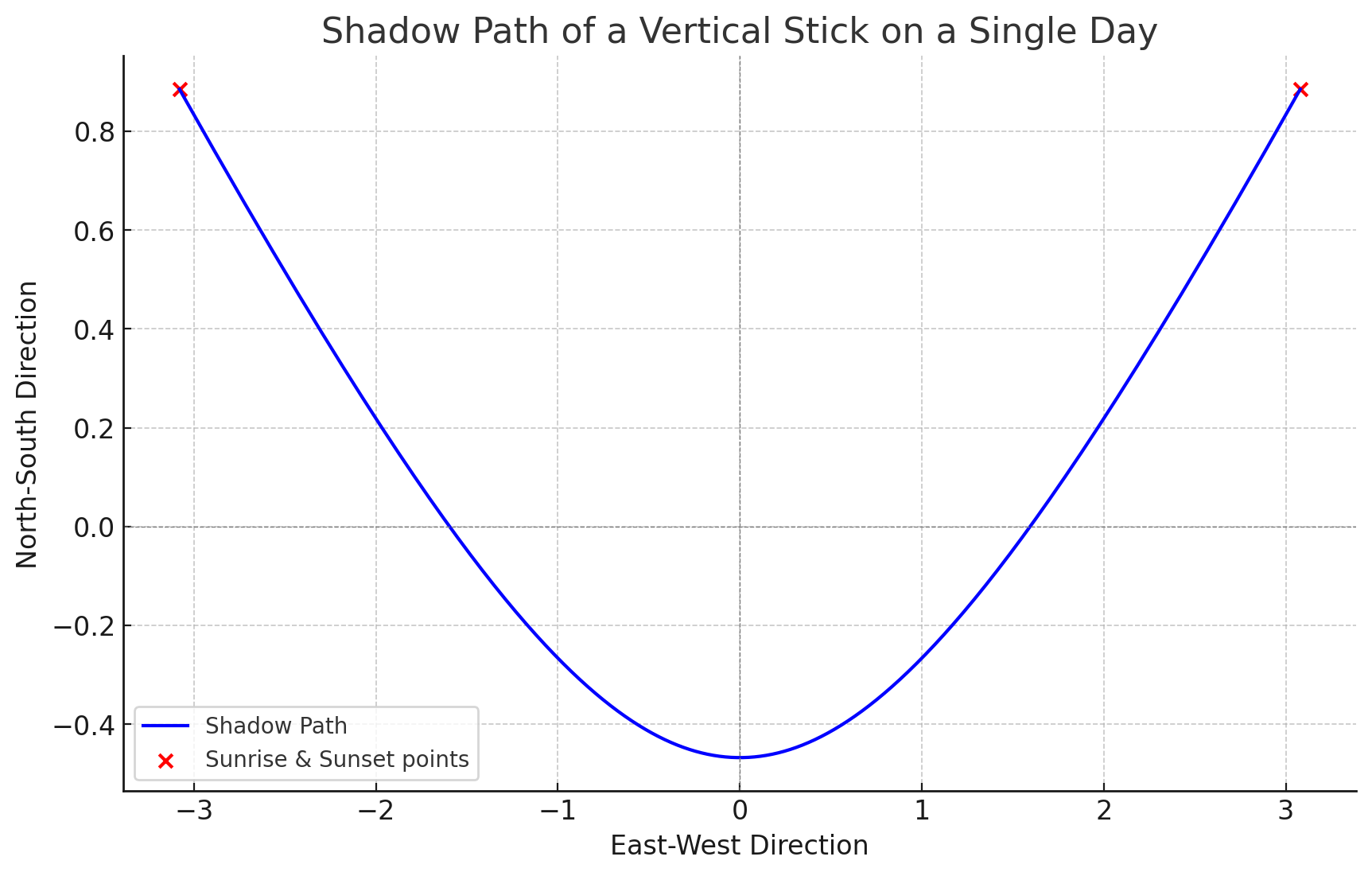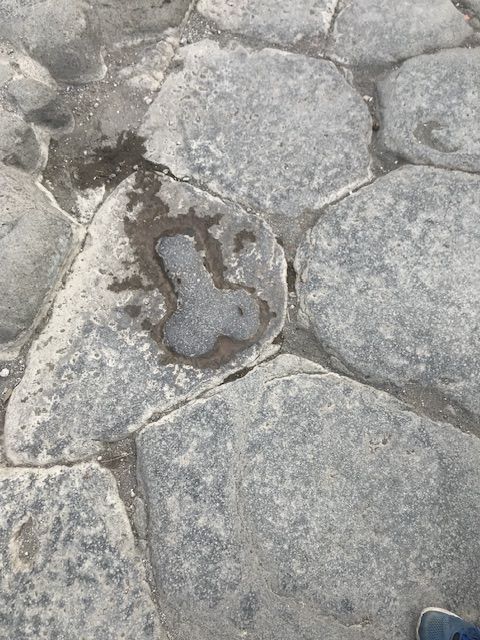Mildly interesting
-
How to Make a Compass
- Place a 90 cm stick on the ground and put a small rock where the tip of the shadow falls.
- Wait ten to fifteen minutes and place a second rock at the point where the tip of the shadow has also moved.
- Draw a line between the two points. This is an east-west line.
- Place the tip of your left foot on the first rock and the tip of your right foot on the second rock; now you will be facing north.
🧐Anywhere on Earth, the first shadow mark is west, and the second is east.

@Mik said in Mildly interesting:
How to Make a Compass
- Place a 90 cm stick on the ground and put a small rock where the tip of the shadow falls.
2 Wait ten to fifteen minutes and place a second rock at the point where the tip of the shadow has also moved.
3 .Draw a line between the two points. This is an east-west line. - Place the tip of your left foot on the first rock and the tip of your right foot on the second rock; now you will be facing north.
Really? I don't think that works. I don't see why it should be east-west in 3.
-
@Mik said in Mildly interesting:
How to Make a Compass
- Place a 90 cm stick on the ground and put a small rock where the tip of the shadow falls.
2 Wait ten to fifteen minutes and place a second rock at the point where the tip of the shadow has also moved.
3 .Draw a line between the two points. This is an east-west line. - Place the tip of your left foot on the first rock and the tip of your right foot on the second rock; now you will be facing north.
Really? I don't think that works. I don't see why it should be east-west in 3.
@Klaus said in Mildly interesting:
@Mik said in Mildly interesting:
How to Make a Compass
- Place a 90 cm stick on the ground and put a small rock where the tip of the shadow falls.
2 Wait ten to fifteen minutes and place a second rock at the point where the tip of the shadow has also moved.
3 .Draw a line between the two points. This is an east-west line. - Place the tip of your left foot on the first rock and the tip of your right foot on the second rock; now you will be facing north.
Really? I don't think that works. I don't see why it should be east-west in 3.
If the sun is moving on an east-west line relative to the stick, the tip of the stick's shadow should also be moving along an east-west line. Where's the problem?
- Place a 90 cm stick on the ground and put a small rock where the tip of the shadow falls.
-
@Klaus said in Mildly interesting:
@Mik said in Mildly interesting:
How to Make a Compass
- Place a 90 cm stick on the ground and put a small rock where the tip of the shadow falls.
2 Wait ten to fifteen minutes and place a second rock at the point where the tip of the shadow has also moved.
3 .Draw a line between the two points. This is an east-west line. - Place the tip of your left foot on the first rock and the tip of your right foot on the second rock; now you will be facing north.
Really? I don't think that works. I don't see why it should be east-west in 3.
If the sun is moving on an east-west line relative to the stick, the tip of the stick's shadow should also be moving along an east-west line. Where's the problem?
@Horace said in Mildly interesting:
@Klaus said in Mildly interesting:
@Mik said in Mildly interesting:
How to Make a Compass
- Place a 90 cm stick on the ground and put a small rock where the tip of the shadow falls.
2 Wait ten to fifteen minutes and place a second rock at the point where the tip of the shadow has also moved.
3 .Draw a line between the two points. This is an east-west line. - Place the tip of your left foot on the first rock and the tip of your right foot on the second rock; now you will be facing north.
Really? I don't think that works. I don't see why it should be east-west in 3.
If the sun is moving on an east-west line relative to the stick, the tip of the stick's shadow should also be moving along an east-west line. Where's the problem?
I let ChatGPT plot a curve of the tip of the shadow for a full day. The degree of curvature depends on the time of the year and on the position of earth, but it will not be a straight line.

- Place a 90 cm stick on the ground and put a small rock where the tip of the shadow falls.
-
@Horace said in Mildly interesting:
@Klaus said in Mildly interesting:
@Mik said in Mildly interesting:
How to Make a Compass
- Place a 90 cm stick on the ground and put a small rock where the tip of the shadow falls.
2 Wait ten to fifteen minutes and place a second rock at the point where the tip of the shadow has also moved.
3 .Draw a line between the two points. This is an east-west line. - Place the tip of your left foot on the first rock and the tip of your right foot on the second rock; now you will be facing north.
Really? I don't think that works. I don't see why it should be east-west in 3.
If the sun is moving on an east-west line relative to the stick, the tip of the stick's shadow should also be moving along an east-west line. Where's the problem?
I let ChatGPT plot a curve of the tip of the shadow for a full day. The degree of curvature depends on the time of the year and on the position of earth, but it will not be a straight line.

@Klaus said in Mildly interesting:
@Horace said in Mildly interesting:
@Klaus said in Mildly interesting:
@Mik said in Mildly interesting:
How to Make a Compass
- Place a 90 cm stick on the ground and put a small rock where the tip of the shadow falls.
2 Wait ten to fifteen minutes and place a second rock at the point where the tip of the shadow has also moved.
3 .Draw a line between the two points. This is an east-west line. - Place the tip of your left foot on the first rock and the tip of your right foot on the second rock; now you will be facing north.
Really? I don't think that works. I don't see why it should be east-west in 3.
If the sun is moving on an east-west line relative to the stick, the tip of the stick's shadow should also be moving along an east-west line. Where's the problem?
I let ChatGPT plot a curve of the tip of the shadow for a full day. The degree of curvature depends on the time of the year and on the position of earth, but it will not be a straight line.

I don't think it was meant to be theoretically an exact east-west line. Close enough for practical purposes.
- Place a 90 cm stick on the ground and put a small rock where the tip of the shadow falls.
-
This image is a comparative chart that shows the evolution of the modern alphabet over a span of 7,000+ years across different cultures and writing systems worldwide.
It traces the development of individual letters from ancient Egyptian hieroglyphs and Semitic scripts through Phoenician, Greek, and other intermediate writing systems, culminating in the modern Latin alphabet.
Each column represents a stage in the evolution of writing, showcasing how each letter has transformed over millennia in different scripts, such as Hieroglyphics, Proto-Sinaitic, Phoenician, Greek, and Arabic, among others. The chart is a visual representation of the continuity and adaptation of characters as they transitioned from one culture to another, demonstrating the shared heritage and interconnectedness of written communication across civilizations.

-
This image is a comparative chart that shows the evolution of the modern alphabet over a span of 7,000+ years across different cultures and writing systems worldwide.
It traces the development of individual letters from ancient Egyptian hieroglyphs and Semitic scripts through Phoenician, Greek, and other intermediate writing systems, culminating in the modern Latin alphabet.
Each column represents a stage in the evolution of writing, showcasing how each letter has transformed over millennia in different scripts, such as Hieroglyphics, Proto-Sinaitic, Phoenician, Greek, and Arabic, among others. The chart is a visual representation of the continuity and adaptation of characters as they transitioned from one culture to another, demonstrating the shared heritage and interconnectedness of written communication across civilizations.

@Mik said in Mildly interesting:
This image is a comparative chart that shows the evolution of the modern alphabet over a span of 7,000+ years across different cultures and writing systems worldwide.
It traces the development of individual letters from ancient Egyptian hieroglyphs and Semitic scripts through Phoenician, Greek, and other intermediate writing systems, culminating in the modern Latin alphabet.
Each column represents a stage in the evolution of writing, showcasing how each letter has transformed over millennia in different scripts, such as Hieroglyphics, Proto-Sinaitic, Phoenician, Greek, and Arabic, among others. The chart is a visual representation of the continuity and adaptation of characters as they transitioned from one culture to another, demonstrating the shared heritage and interconnectedness of written communication across civilizations.

Uh...
They completely missed all the futharks. Like, all of them.
-
In Pompei on the ancient road that came up from the port there was - and is - a sign for sailors telling them where the brothel was.
Of course most were illiterate so they used a universal symbol. Photo my own.

I will add that’s my first ever dick pic on TNCR.
-
Sean’s Bar, located in Athlone, Ireland, holds the distinction of being the oldest pub in Ireland, with a history dating back over 1,000 years. According to historical records and archaeological evidence, the establishment was originally built in the 10th century, situated along the ancient route that once connected the east and west of Ireland. This venerable pub has evolved over centuries, reflecting Ireland's rich heritage and serving as a social hub for both locals and travelers. The structure itself, with its traditional thatched roof and wooden interior, has preserved much of its historical charm, making it a living monument to Ireland's past.
Throughout its long history, Sean’s Bar has witnessed significant events and changes in Ireland, from medieval times through the turbulent eras of the English conquest and Irish independence. It has served as a meeting place for historical figures, poets, and revolutionaries. Despite the passage of time and numerous renovations, Sean’s Bar has maintained its authentic atmosphere, providing patrons with a unique experience that intertwines with Ireland’s historical narrative. Today, it remains a popular destination for visitors who wish to experience a piece of Irish history while enjoying a pint in an atmosphere that has been enjoyed for centuries.
-
Lazada is a Amazon-like selling platform in SE Asia, including Thailand. A recent listing.


-
With the election of the lady in North Dakota, Mississippi is the only state never to have elected a woman to the House of Representatives
-
Sean’s Bar, located in Athlone, Ireland, holds the distinction of being the oldest pub in Ireland, with a history dating back over 1,000 years. According to historical records and archaeological evidence, the establishment was originally built in the 10th century, situated along the ancient route that once connected the east and west of Ireland. This venerable pub has evolved over centuries, reflecting Ireland's rich heritage and serving as a social hub for both locals and travelers. The structure itself, with its traditional thatched roof and wooden interior, has preserved much of its historical charm, making it a living monument to Ireland's past.
Throughout its long history, Sean’s Bar has witnessed significant events and changes in Ireland, from medieval times through the turbulent eras of the English conquest and Irish independence. It has served as a meeting place for historical figures, poets, and revolutionaries. Despite the passage of time and numerous renovations, Sean’s Bar has maintained its authentic atmosphere, providing patrons with a unique experience that intertwines with Ireland’s historical narrative. Today, it remains a popular destination for visitors who wish to experience a piece of Irish history while enjoying a pint in an atmosphere that has been enjoyed for centuries.
@Mik said in Mildly interesting:
Sean’s Bar, located in Athlone, Ireland, holds the distinction of being the oldest pub in Ireland, with a history dating back over 1,000 years. According to historical records and archaeological evidence, the establishment was originally built in the 10th century, situated along the ancient route that once connected the east and west of Ireland. This venerable pub has evolved over centuries, reflecting Ireland's rich heritage and serving as a social hub for both locals and travelers. The structure itself, with its traditional thatched roof and wooden interior, has preserved much of its historical charm, making it a living monument to Ireland's past.
Throughout its long history, Sean’s Bar has witnessed significant events and changes in Ireland, from medieval times through the turbulent eras of the English conquest and Irish independence. It has served as a meeting place for historical figures, poets, and revolutionaries. Despite the passage of time and numerous renovations, Sean’s Bar has maintained its authentic atmosphere, providing patrons with a unique experience that intertwines with Ireland’s historical narrative. Today, it remains a popular destination for visitors who wish to experience a piece of Irish history while enjoying a pint in an atmosphere that has been enjoyed for centuries.
I’m pretty sure the Irish raiders of 1100-1200 didn’t have such nice glass mugs, nor was the beer quite as clear… And they certainly didn’t hold it and gingerly sip it like Finley sipping a glass of juice..
-
@Mik said in Mildly interesting:
Sean’s Bar, located in Athlone, Ireland, holds the distinction of being the oldest pub in Ireland, with a history dating back over 1,000 years. According to historical records and archaeological evidence, the establishment was originally built in the 10th century, situated along the ancient route that once connected the east and west of Ireland. This venerable pub has evolved over centuries, reflecting Ireland's rich heritage and serving as a social hub for both locals and travelers. The structure itself, with its traditional thatched roof and wooden interior, has preserved much of its historical charm, making it a living monument to Ireland's past.
Throughout its long history, Sean’s Bar has witnessed significant events and changes in Ireland, from medieval times through the turbulent eras of the English conquest and Irish independence. It has served as a meeting place for historical figures, poets, and revolutionaries. Despite the passage of time and numerous renovations, Sean’s Bar has maintained its authentic atmosphere, providing patrons with a unique experience that intertwines with Ireland’s historical narrative. Today, it remains a popular destination for visitors who wish to experience a piece of Irish history while enjoying a pint in an atmosphere that has been enjoyed for centuries.
I’m pretty sure the Irish raiders of 1100-1200 didn’t have such nice glass mugs, nor was the beer quite as clear… And they certainly didn’t hold it and gingerly sip it like Finley sipping a glass of juice..
@LuFins-Dad said in Mildly interesting:
@Mik said in Mildly interesting:

I’m pretty sure the Irish raiders of 1100-1200 didn’t have such nice glass mugs, nor was the beer quite as clear… And they certainly didn’t hold it and gingerly sip it like Finley sipping a glass of juice..
Yeah, I’m pretty sure that’s not an actual photo from that era.


